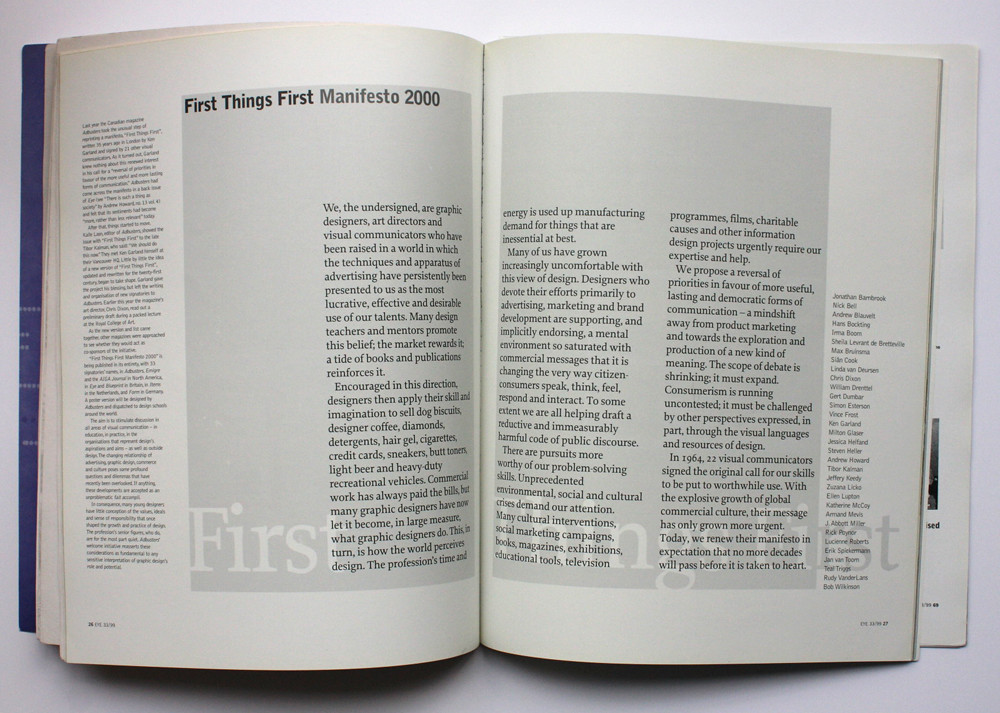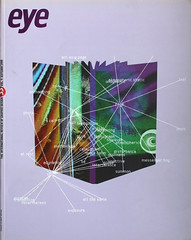Autumn 1999
First Things First Manifesto 2000
Nick Bell
Andrew Blauvelt
Hans Bockting
Irma Boom
Sheila Levrant de Bretteville
Max Bruinsma
Sian Cook
Linda van Deursen
Chris Dixon
William Drenttel
Gert Dumbar
Simon Esterson
Vince Frost
Ken Garland
Milton Glaser
Jessica Helfand
Steven Heller
Andrew Howard
Tibor Kalman
Jeffery Keedy
Zuzana Licko
Ellen Lupton
Katherine McCoy
Armand Mevis
Abbott Miller
Rick Poynor
Lucienne Roberts
Erik Spiekermann
Jan van Toorn
Teal Triggs
Rudy VanderLans
Bob Wilkinson
various designers
Thirty-three visual communicators renew the 1964 call for a change of priorities

We, the undersigned, are graphic designers, art directors and visual communicators who have been raised in a world in which the techniques and apparatus of advertising have persistently been presented to us as the most lucrative, effective and desirable use of our talents. Many design teachers and mentors promote this belief; the market rewards it; a tide of books and publications reinforces it.
Encouraged in this direction, designers then apply their skill and imagination to sell dog biscuits, designer coffee, diamonds, detergents, hair gel, cigarettes, credit cards, sneakers, butt toners, light beer and heavy-duty recreational vehicles. Commercial work has always paid the bills, but many graphic designers have now let it become, in large measure, what graphic designers do. This, in turn, is how the world perceives design. The profession’s time and energy is used up manufacturing demand for things that are inessential at best.
Many of us have grown increasingly uncomfortable with this view of design. Designers who devote their efforts primarily to advertising, marketing and brand development are supporting, and implicitly endorsing, a mental environment so saturated with commercial messages that it is changing the very way citizen-consumers speak, think, feel, respond and interact. To some extent we are all helping draft a reductive and immeasurably harmful code of public discourse.
There are pursuits more worthy of our problem-solving skills. Unprecedented environmental, social and cultural crises demand our attention. Many cultural interventions, social marketing campaigns, books, magazines, exhibitions, educational tools, television programmes, films, charitable causes and other information design projects urgently require our expertise and help.
We propose a reversal of priorities in favour of more useful, lasting and democratic forms of communication – a mindshift away from product marketing and toward the exploration and production of a new kind of meaning. The scope of debate is shrinking; it must expand. Consumerism is running uncontested; it must be challenged by other perspectives expressed, in part, through the visual languages and resources of design.
In 1964, 22 visual communicators signed the original call for our skills to be put to worthwhile use. With the explosive growth of global commercial culture, their message has only grown more urgent. Today, we renew their manifesto in expectation that no more decades will pass before it is taken to heart.
Jonathan Barnbrook
Nick Bell
Andrew Blauvelt
Hans Bockting
Irma Boom
Sheila Levrant de Bretteville
Max Bruinsma
Siân Cook
Linda van Deursen
Chris Dixon
William Drenttel
Gert Dumbar
Simon Esterson
Vince Frost
Ken Garland
Milton Glaser
Jessica Helfand
Steven Heller
Andrew Howard
Tibor Kalman
Jeffery Keedy
Zuzana Licko
Ellen Lupton
Katherine McCoy
Armand Mevis
J. Abbott Miller
Rick Poynor
Lucienne Roberts
Erik Spiekermann
Jan van Toorn
Teal Triggs
Rudy VanderLans
Bob Wilkinson
Background
Last year the Canadian magazine Adbusters took the unusual step of reprinting a manifesto, ‘First Things First’, written 35 years ago in London by Ken Garland and signed by 21 other visual communicators. As it turned out, Garland knew nothing about this renewed interest in his call for a ‘reversal of priorities in favour of the more useful and more lasting forms of communication.’ Adbusters had come across the manifesto in a back issue of Eye (see ‘There is such a thing as society’ by Andrew Howard, Eye no. 13 vol. 4) and felt that its sentiments had become ‘more, rather than less relevant’ today.
After that, things started to move. Kalle Lasn, editor of Adbusters, showed the issue with ‘First Things First’ to the late Tibor Kalman, who said: ‘We should do this now. ‘They met Ken Garland himself at their Vancouver HQ. Little by little the idea of a new version of ‘First Things First’, updated and rewritten for the twenty-first century, began to take shape. Garland gave the project his blessing, but left the writing and organisation of new signatories to Adbusters. Earlier this year [1999] the magazine’s art director, Chris Dixon, read out a preliminary draft during a packed lecture at the Royal College of Art.
As the new version and list came together, other magazines were approached to see whether they would act as co-sponsors of the initiative.
‘First Things First Manifesto 2000’ is being published in its entirety, with 33 signatories’ names, in Adbusters, Emigre and the AIGA Journal in North America, in Eye and Blueprint in Britain, in Items in the Netherlands, and Form in Germany. A poster version will be designed by Adbusters and dispatched to design schools around the world.
The aim is to stimulate discussion in all areas of visual communication – in education, in practice, in the organisations that represent design’s aspirations and aims – as well as outside design. The changing relationship of advertising, graphic design, commerce and culture poses some profound questions and dilemmas that have recently been overlooked. If anything, these developments are accepted as an unproblematic fait accompli.
In consequence, many young designers have little conception of the values, ideals and sense of responsibility that once shaped the growth and practice of design. The profession’s senior figures, who do, are for the most part quiet. Adbusters’ welcome initiative reasserts these considerations as fundamental to any sensitive interpretation of graphic design’s role and potential.
First published in Eye no. 33 vol. 9, 1999
Eye is the world’s most beautiful and collectable graphic design journal, published quarterly for professional designers, students and anyone interested in critical, informed writing about graphic design and visual culture. It is available from all good design bookshops and online at the Eye shop, where you can buy subscriptions and single issues.

